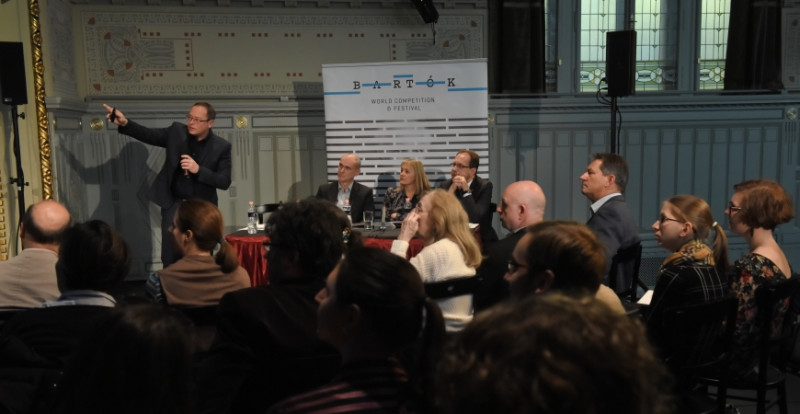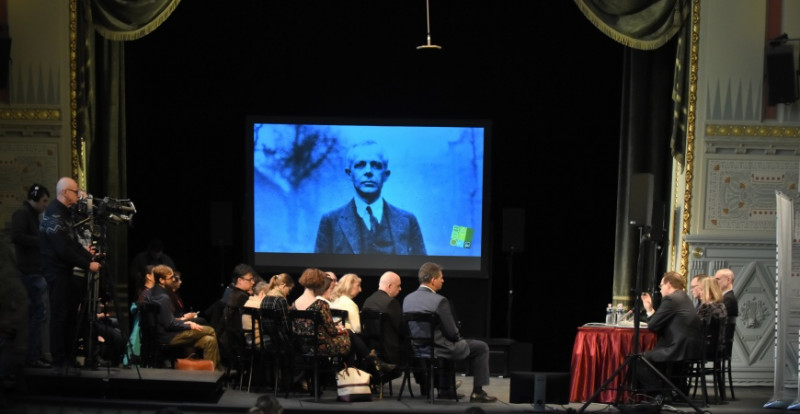LISZT ACADEMY ANNOUNCES THE BARTÓK WORLD COMPETITION & FESTIVAL
The Liszt Academy has launched the Bartók World Competition and Festival as the closing chord of the 2016 Bartók Year. The competition debuts with the violin category in September 2017. Violinists under the age of 30 can submit applications with a deadline of 26 March 2017.
Music competitions are key events in international music and vital catalysts in the professional development of gifted young artists, in bringing them to world attention and in connecting them to the concert scene, but cultural bridges can also be built at international competitions. These thoughts were voiced at a press conference heralding the Bartók World Competition and Festival in the Sir Georg Solti Chamber Hall of the Liszt Academy on 6 December 2016. The event, positioned in the elite league of top international music competitions, is intended not only as an instrumental review announced every other year in a different category; according to plans, it is also a festival attracting world attention augmented with a composers’ competition plus musicology symposium built around the oeuvre of Bartók, as well as offering programmes of interest to the general public.
In his speech, Dr. Péter Hoppál said that the Bartók World Competition and Festival planned for September 2017 would be a worthy coda to the Bartók Year. The state secretary for culture added that the government was sponsoring this inaugural event to the tune of HUF 160 million and a maintainer’s decision concerning the long-term future of the competition was under review. At the end of his speech Péter Hoppál congratulated the Liszt Academy, stating that the institution had enhanced the cultural prestige and attraction of Hungary through the regular organization of premium quality international competitions and contributed to the development of cultural tourism and culture consumption in Hungary.
Dr. Andrea Vigh said: “Bartók is at home here.” Bartók’s music is universal, its significance is global, yet his mother tongue and musical roots are tied to Hungary, and the Liszt Academy, as the former ‘home’ of Bartók, has an obligation to cherish his oeuvre and deepen the meaning and significance of Bartók’s music at international level. The president of the Liszt Academy emphasized that, through its complexity, the Bartók World Competition and Festival intended to differentiate itself from all other competitions.

The idea of the Bartók World Competition and Festival came from Dr. Andrea Vigh. The professional concept of the competition was worked out by the Liszt Academy leadership under the artistic direction of the president, while the foremost violin professors of the institution compiled the material for the first competition announced for violinists. Imre Szabó Stein, communications chief of the Liszt Academy, is responsible for the development of the format, the origination of the competition’s creative concept, image, publication and marketing portfolio, the drafting and implementation of the complete communications strategy, while the arrangement of the competition project and organizational tasks are overseen by programme director András Csonka. On the basis of the decision of the government of Hungary, the Bartók World Competition and Festival is organized by the Liszt Academy with the support of the Ministry of Human Capacities.
The Liszt Academy also organizes an international series of programmes in the framework of Bartók Year. Intensive educational and concert programmes involving teachers and students of partner institutions were arranged in cooperation with the Ministry of Foreign Affairs and Trade and the Liszt Ferenc Academy of Music in Tokyo, Helsinki and Zagreb. Click here for further details of the plan of the series and its destinations.
International Violin Competition 2017
The Liszt Academy announces the first Bartók World Competition and Festival (10-17 September 2017) in the violin category. At the media event, András Csonka said that applications for the 2017 violin competition were being accepted from 6 December 2016. He went on to detail the various rounds, prizes, jury and repertoire of the contest.

In the course of the five rounds of the international violin competition with total prize money exceeding €40,000, Bartók’s principal violin works will be performed. The first, virtual qualification round takes place on the basis of videos submitted to the competition website, then during the live rounds in the autumn organized at the Liszt Academy applicants initially play one movement from the first or second rhapsody by Bartók, plus a movement from Bach’s violin solo sonatas or partitas. In the semi-finals, competitors test their skills with a 30-minute programme made up from Bartók violin sonatas, the most significant sonatas from violin literature, as well as a virtuoso piece. Those six contestants making it through to the final must perform a Mozart violin concerto, and the ultimate ranking is decided in the finale in which the three best competitors perform concertos by Bartók, Beethoven, Brahms or Tchaikovsky together with the Hungarian Radio Symphony Orchestra under the baton of János Kovács.
Hungarians Vilmos Szabadi, Barnabás Kelemen and Tibor Tallián participate in the work of the jury, joined by distinguished foreign violinists and professors Salvatore Accardo, Qian Zhou, Ivan Zenaty, Krzysztof Wegrzyn, Joel Smirnoff and Takashi Shimizu, all of whom accepted the Liszt Academy invitation to sit on the jury.
Violinists under the age of 30 can apply to the competition by uploading three video excerpts. Deadline for applications is 26 March 2017, but those applying by 15 February are entitled to a 50% discount on the registration fee inasmuch as they get through to the live rounds in the autumn (only those passing the qualification stage have to pay the entry fee of €200). The precise repertoire list, all information and the online application form for the Bartók World Competition and Festival – International Violin Competition 2017 are available on the competition website at bartokworldcompetition.hu.
Musicology conference, composers’ competition and festival programmes
The Bartók World Competition and Festival is much more than just a music competition: it is at the same time a scientific review and festival targeting a broad audience. Every other year, beside the competitions in instrumental categories there will be a scientific conference held in the Institute of Musicology of the Hungarian Academy of Sciences, which is also home to the Bartók archive. Dr. Pál Richter, director of the Institute of Musicology, said that symposiums would approach the Bartók oeuvre so that the given theme (in 2017, Bartók and the violin) was illuminated by the very latest research from Hungary and abroad. This creates the opportunity whereby Bartók constantly features not only in the life of performers but in musicology as well.

The inventors of the Bartók World Competition and Festival are fully aware that for many, even today the music of Bartók is difficult to grasp. The objective of festival programmes built around the competitions is nothing less than bridging this gap with the help of family concerts, lectures, games, films and communication mobilizing wide sections of society, and to reveal the elusive figure of Bartók from close up.
According to the long-term vision, the Bartók World Competition and Festival is built around the most characteristic strands of the Bartók oeuvre, that is, piano, violin, chamber music and composition, in a five-year cycle. The individual instrumental competitions are organized every other year, with composer competitions in between, which always tie into the forthcoming instrumental category (later on the competition will be extended with a review of folk music). This distinctive structure is effective both at drawing the attention of the best instrumentalists of the upcoming musician generation to the works of Bartók and at the same time inspiring young composers to create new works written in the spirit of Bartók.
From the creation of image to the announcement
Speaking at the press briefing, Imre Szabó Stein pointed out that the aim of the Liszt Academy was to position the Bartók World Competition and Festival in the vanguard of the most prestigious international music competitions including the Tchaikovsky competition in Moscow, the Queen Elisabeth Competition in Brussels and the ARD International Music Competition in Munich. “In the course of creating the Bartók World Competition and Festival concept, image and communications strategy, we wished to articulate and present the relation of Bartók and the competition in an innovative way, more profoundly and with greater emphasis than ever. We started from the fact that the image is not a kind of ‘packaging’ but rather an integral part of the message, which is capable – almost immediately – of assigning the rank of this newly launched international competition,” said Imre Szabó Stein, adding that “… it is also absolutely critical in today’s world of information societies how the competition finds its way into the global media space. Any international competition that does not make news around the world remains, despite its international motivation, within the country of origin as far as impact is concerned.” The image of the Bartók World Competition and Festival is deliberately puritan, its inspiration can be interpreted as a metaphor of the Bartók oeuvre, and at the same time it draws on the concept of the bridge structure referring to the compositional structure favoured by Bartók. Imre Szabó Stein presented the logo series and image, advertisements, publication, new website, and details of the international media campaign all developed after careful preparatory and extended creative efforts. To wind up the press conference, there was a screening of the spot heralding the competition.
The short film of the Bartók World Competition and Festival was made in synergy with the new image film ‘Music Without Borders’ of the Liszt Academy focusing on Bartók. The 45-second film etude follows a young musician from the Liszt Academy who is listening to an original recording of Bartók’s Allegro Barbaro. The spot juggles with time-shifts on real and imaginary borders, before the perspective widens into the infinite and brings the main character into contact with Bartók, and the composer himself looks out of the screen. Imre Szabó Stein is the author and creative producer of the film, Dávid Géczy is director (he also directed the multiple prize-winning 2015 image spot of the Liszt Academy Concert Centre). The cameraman is Balázs Dobóczy and the roles of musicians were played by students of the Liszt Ferenc Academy of Music.
The media campaign heralding the Bartók World Competition and Festival and relying to a considerable extent on the short film appears in top music publications (The Strad, Gramophone, Classical Music etc.) as well as in opinion-shaping media giants (The New York Times, Le Monde, Der Spiegel etc.). The campaign promoting the announcement of the competition fulfils an emphatic image-building role at the same time: advertisements are intended to contribute to the international promotion not only of the Bartók World Competition and Festival but also the Liszt Academy, Hungary and Bartók’s oeuvre. In parallel with all this, the call for the Bartók World Competition and Festival has (in international terms) a modest budget, but as a consequence of a highly refined search marketing campaign and the international system of relations of the Liszt Academy, it will find its way to the students and professors of Europe’s and the world’s leading music institutions of higher education.

During the press briefing on 6 December a collection of Bartók folk song arrangements were performed by Vilmos Szabadi, professor of violin studies at the Liszt Academy and a member of the jury for the Bartók World Competition and Festival – International Violin Competition 2017, and Aya Shirai, cello student at the Liszt Ferenc Academy of Music.
On the basis of the decision of the government of Hungary, the Bartók World Competition and Festival is organized by the Liszt Academy with the support of the Ministry of Human Capacities.


